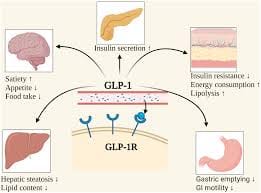- Aeviva
- Posts
- Let’s Get the Facts Straight About Ozempic: The Weight Loss Drug Taking the World by Storm
Let’s Get the Facts Straight About Ozempic: The Weight Loss Drug Taking the World by Storm
Ozempic Uncovered: Facts, Science, and the Weight Loss Revolution
It’s been dubbed the “celebrity weight loss secret,” sparked debates across the health and wellness industries, and even inspired memes on social media. Ozempic is not just a drug; it’s a cultural phenomenon. But what is Ozempic, and why has it captured the world’s attention?
Originally designed as a diabetes medication, this injectable treatment has become a game-changer for weight loss. With endorsements from celebrities and evidence-backed results, Ozempic has dominated headlines—but not without controversy. Let’s break down the science, the stories, and the facts about this groundbreaking drug.

Want to get the most out of ChatGPT?
ChatGPT is a superpower if you know how to use it correctly.
Discover how HubSpot's guide to AI can elevate both your productivity and creativity to get more things done.
Learn to automate tasks, enhance decision-making, and foster innovation with the power of AI.
What Is Ozempic?
Ozempic is a brand-name medication developed by the Danish pharmaceutical giant Novo Nordisk. Its active ingredient, semaglutide, is a GLP-1 receptor agonist approved by the FDA in 2017 for type 2 diabetes. However, its significant weight loss effects led to its off-label use for obesity, ultimately resulting in the release of Wegovy, a higher-dose version specifically for weight management.
💡 Fun Fact: Novo Nordisk is expected to generate over $16 billion annually from Ozempic and Wegovy by 2025, making it one of the most lucrative drugs in the world.
Why Is Ozempic So Popular?
The drug’s popularity stems from its incredible results. With users often losing 10-15% of their body weight, it has quickly become a sought-after treatment for those struggling with obesity or looking for non-surgical weight loss solutions.
Celebrity endorsements have further boosted its appeal. Elon Musk credited Wegovy for his weight loss, and countless influencers have shared their success stories online. But it’s not just about aesthetics—Ozempic offers significant health benefits, making it a dual-purpose medication for better metabolic health.
The GLP-1 Path: How It Works
To understand Ozempic, it’s essential to grasp its mechanism of action.
What is GLP-1?
GLP-1 (glucagon-like peptide-1) is a hormone naturally produced in the gut. It helps regulate blood sugar levels by signaling the pancreas to release insulin and slowing down digestion.How Does Ozempic Enhance This Process?
Ozempic is a GLP-1 receptor agonist, meaning it mimics this hormone’s effects. By binding to GLP-1 receptors, it reduces appetite, prolongs feelings of fullness, and regulates blood sugar levels effectively.
💡 Laic Explanation: It’s like having a “hunger off switch,” helping you eat less without feeling deprived.

Effects of Ozempic on the Body
Ozempic’s dual role as a diabetes medication and weight loss drug has positioned it as a revolutionary solution for many.
Health Benefits:
Blood Sugar Control: Ozempic lowers blood sugar levels, making it highly effective for type 2 diabetes.
Weight Loss: Most users experience substantial weight reduction, especially around the abdominal area.
Cardiovascular Benefits: Studies show that semaglutide reduces the risk of heart attacks and strokes in high-risk individuals.
Side Effects:
Common: Nausea, vomiting, diarrhea, and fatigue are typical during the adjustment phase.
Rare but Serious: Pancreatitis, gallbladder issues, and potential thyroid complications in those predisposed.
The Next Generation: Alternatives and Competitors
While Ozempic remains a gold standard, other drugs are stepping up to challenge its dominance:
Wegovy: A higher-dose version of Ozempic, also by Novo Nordisk, designed exclusively for weight management.
Mounjaro (tirzepatide): Developed by Eli Lilly, this dual agonist targets both GLP-1 and GIP receptors, delivering faster and more significant weight loss.
Rybelsus: An oral form of semaglutide for those who prefer pills over injections.
Triple Agonists: New experimental drugs in the pipeline aim to target multiple metabolic pathways for even better results.
💡 Fun Fact: Mounjaro has been shown to reduce body weight by up to 22%, outperforming Ozempic in clinical trials.
The Cost of Ozempic
The financial commitment of Ozempic can be steep, particularly for long-term users:
USA: Without insurance, a month’s supply costs between $900-$1,200.
EU: Prices are lower, averaging €200-€300 per month, depending on subsidies and healthcare policies.

💡 Reality Check: Affordability remains a significant barrier, especially for those who require prolonged treatment to maintain results.
Are There Natural Supplements That Boost GLP-1?
While medications like Ozempic are designed to mimic GLP-1, some natural supplements have been shown to enhance the body’s production of this hormone. Although their effects may not be as pronounced as pharmaceutical interventions, they can still provide notable benefits when combined with a healthy lifestyle.
Supplements That May Support GLP-1 Production:
Berberine: Found in certain plants, this compound helps regulate blood sugar levels and may naturally increase GLP-1 secretion.
Curcumin: The active ingredient in turmeric, curcumin has anti-inflammatory effects and supports gut health, indirectly promoting GLP-1 activity.
Cinnamon Extract: Known to stabilize blood sugar, it can enhance insulin sensitivity and support GLP-1 signaling.
Probiotics: Certain strains of gut-friendly bacteria, like Lactobacillus and Bifidobacterium, have been linked to increased GLP-1 secretion.
Omega-3 Fatty Acids: Found in fish oil and algae, omega-3s may help modulate GLP-1 pathways and improve metabolic health.
A Pharmacist’s Perspective
As a pharmacist, I see Ozempic as a groundbreaking advancement in managing obesity and diabetes. Its mechanism is well-researched, its results are compelling, and it offers hope to individuals who have struggled with weight-related health issues for years.
However, it’s not a “magic shot.” Ozempic works best when combined with healthy lifestyle changes, including diet and exercise. The cost is a valid concern, and while the drug offers excellent results, it’s important to weigh the benefits against the financial and potential side effects.
Pro Tip: Dinner drama doesn’t have to be a thing.
Order Tovala instead, and enjoy zero stress with every meal. Tovala’s menu changes every week so there’s always something new—and their at-home delivery makes grocery shopping virtually non-existent. Savor freshly-cooked flavors in every meal—with just 1-minute of prep.
Poll:
If you’re reading this, how would you rate our newsletter?
If you’re reading this, how would you rate our newsletter? |
💡 Your feedback helps us improve – let us know what you think!
Ozempic has changed the landscape of weight loss and diabetes treatment, but it’s not without controversy. While it offers life-changing benefits, it’s essential to approach it as part of a comprehensive lifestyle plan rather than a quick fix.
As we look to the future, innovations in pharmaceuticals will likely bring even more effective and accessible solutions, but for now, Ozempic remains a pioneer in its field.
Take-Home Message
What is Ozempic? A GLP-1 agonist that controls appetite and blood sugar.
Why is it popular? Significant weight loss results, endorsed by celebrities.
How does it work? Mimics natural GLP-1 to reduce hunger and slow digestion.
Alternatives: Wegovy, Mounjaro, and upcoming triple agonists.
Cost: $900–$1,200 in the US, €200–€300 in the EU.
Pharmacist’s Opinion: Revolutionary but requires commitment and affordability considerations.


Reply